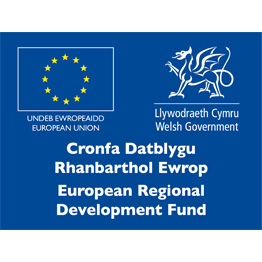Crossflow Energy are renewable energy technology specialists. They are focused on supplying wind-based energy solutions for both developing and developed countries.
By solving the issues that have inhibited the adoption of ‘small wind’ technology, Crossflow want to make renewable wind power a real, accessible and affordable fossil fuel alternative for developing nations.
The company also wants to open up small wind power to a wide range of industries and applications in the UK and overseas such as across commercial and public buildings, industrial and retail settings, telecoms, as part of road and rail infrastructure. Crossflow wants small wind technology to become as common place as solar and really help in the world’s drive to Net Zero.
Collaboration
Through the ASTUTE2020+ academic partnership, both Swansea and Aberystwyth Universities collaborated with Crossflow on two independent projects; the former developed a range of novel vertical wind turbines, and the latter portable hybrid energy systems. ASTUTE provided experimental and computational expertise that, together with Crossflow’s industry knowledge and experience, were able to solve the complex engineering challenges faced by the company. This combined knowledge and collaborative approach to research, development, and innovation helped make significant inroads into Crossflow’s pursuit of clean, reliable energy generation.
Challenges
Following on from a previous project between 2010 – 2015, Crossflow were seeking further support from ASTUTE2020+ to identify, from prototype trials, an appropriate method of processing turbine sensor data when at full-scale. The aim was to use this data to validate computational fluid dynamic simulations that could predict, with confidence, the impact different environmental variables would have on a turbine’s energy conversion process. Swansea University worked with Crossflow on this project.
Aberystwyth collaborated with Crossflow to find a way to develop and deploy a remote monitoring system for their hybrid energy units that would alert engineers to conditions where action needs to be taken. Doing so would make it possible to deploy IES units in remote locations across the world whilst being able to access product improvement data from any geographical location.
Solutions
Computational Fluid Dynamic Simulations
Crossflow commissioned a prototype turbine together with an array of sensors and a data acquisition system, and the Swansea team assisted in finding an appropriate method for data processing. Together, they deployed an advanced data reduction method that fed data from the turbine sensors into their computational fluid dynamic simulations. By conducting numerical modelling activities, they were able to formulate an appropriate dynamic response algorithm for the Physica modelling software that allowed fluctuating wind readings of different strengths and source locations to be input. The data gathered enabled Crossflow to better understand the responses and behaviors of their turbines under changing weather conditions.
Remote Conditioning Monitoring
Crossflow’s team developed an innovative solution to extracting data from the hybrid energy system units using node-red and exporting it to Google Firebase. Doing so enabled the Aberystwyth team to begin designing and developing the required mobile monitoring software. Their collaborative efforts led to the new software being extended to a prototype hybrid energy system in Trinidad, where it was able to successfully monitor its systems with problems being communicated remotely to IOS and Android smartphones. This provided live details of what was happening at the site 24 hours a day.
Impact
The success of this project enabled Crossflow to move confidently to the commercialisation phase with a clear understanding of the capabilities of their turbines and how to monitor and maintain them.
The project has helped Crossflow resolve the issues which historically have inhibited the take up of small wind technology. The turbine’s low rotational speed, creates minimal noise and ultra-low vibrations, extending its operational uptime and minimising maintenance. The turbine design is bird and bat friendly, addressing planning concerns, even in the most ecologically sensitive sites. It can be deployed as a standalone entity or combined with solar and battery technology to enhance renewable energy generation in either new build or retrofit applications.
As a result, Crossflow have been able to identify a wide range of potential markets for their technology. These include commercial and public buildings, road and rail infrastructure, telecoms and in challenging environments such as remote, ecologically sensitive locations.
As a first step in this commercialisation Crossflow have partnered with Vodafone in developing their turbine technology into self-powered mobile network towers to improve rural connectivity in the UK. Their first Eco-Tower is being installed early in 2022. These Eco-Towers will overcome the challenges and costs associated with connecting remote locations to the national grid, whilst also reducing energy consumption patterns and reducing carbon emissions.
As a direct result of the collaboration with ASTUTE2020+, Crossflow has:
- Introduced one new product to the market
- Created two new jobs: one role to support the commercialisation of the wind turbines, and a power engineer for the demo rig in Trinidad
- Gained the ability to install and support intelligent remote monitoring software at their plants
- Gained the confidence to move into the commercialisation phase with a better understanding of their product
- Created a partnership with Vodafone to further develop the turbine technology designed in collaboration with ASTUTE2020+
These successful projects demonstrate the power of industry-academia collaboration, and showcase their unique ability to drive meaningful, positive change through cutting-edge research and innovation. The solutions developed by Crossflow and ASTUTE contribute to global efforts to reach the 1.5 degrees global warming target agreed at COP26, providing an affordable renewable energy technology that can reduce fossil fuel dependency worldwide. Together, they have made significant progress in developing an energy conversion technology that will lead to a greener, cleaner, and more sustainable future for our planet.


